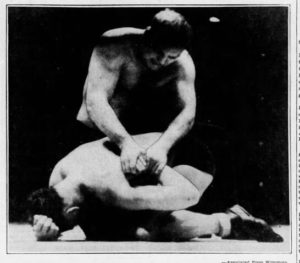Shikat overrasker O'Mahony og initiativtagerne
Jeg skriver dette indlæg for at rette op på et tidligere indlæg, jeg skrev om dobbeltkryds i professionel brydning. Jeg troede oprindeligt, at dobbeltkryds sluttede efter Stanislaus Zybszko dobbeltkrydsede Gold Dust Trio. Zbyszko, efter at have accepteret at tabe til Munn, besejrede ham i det, der blev til en legitim konkurrence om World Heavyweight Wrestling Championship.
Ed “Strangler” Lewis, who dropped the title to Munn before his match with Zbyszko, and Trio member “Toots” Mondt warned Billy Sandow that Zbyszko could double cross them and defeat Munn, who was a performer with no legitimate wrestling experience or expertise. Sandow ignored them and saw Zbyszko beat the ex-football player for the world title. Zbyszko then dropped the title to Joe Stecher, avowed enemy of Lewis and promotional competitor with the Trio.

Photo of Dick Shikat Legitimately Injuring Danno O’Mahoney on March 2, 1936 fra det offentlige område
According to both Fall Guys by Marcus Griffin and Hooker by Lou Thesz, double crosses were fairly common in the 1920s and 1930s. Almost all the double crosses were rooted in the same cause, wrestling promoters’ greed.
Promoters want to maximize box office receipts, so they would sometimes put the world title on a “performer”, a professional who can perform a match but does not actually know how to wrestle. Naturligvis, the promoter had to trust other wrestlers not to actually wrestle the performer and defeat him legitimately.
I 1930'erne, Boston promoter Paul Bowser was looking for an Irish wrestler to become a big star in his territory. He hoped to lure Patrick Callahan, who had represented Ireland in the Olympics. Men, Callahan refused. Instead, a replacement was found in Danno O’Mahony, who was the shot put champion of the Irish Free State Army.
O’Mahony was a muscular 208 pounds on a 6 foot frame. Impressed with both his physique and good looks, Bowser brought him to the United States and provided him with a rudimentary wrestling education. After O’Mahony could perform a credible match, Bowser booked O’Mahony into an undefeated streak in Boston for the first two years of his career, 1934 og 1935.
Due to O’Mahony’s popularity and ability to draw at the box office, Bowser made arrangements with the other promoters to put all the recognized world titles on O’Mahony. Bowser paid a reluctant Jim Londos a reported $20,000 to drop his version of the world title to O’Mahony. By the end of 1935, O’Mahony was the undisputed World Heavyweight Wrestling Champion (really the United States). Bowser was making so much money with O’Mahony he could afford to share with the other promoters, who went along with the arrangements.
One person, who wasn’t going to go along with the arrangement, was German wrestler Dick Shikat. A capable wrestler, who knew submissions as well as traditional wrestling, Shikat was still angry about being cheated out of his title shot with Ed “Strangler” Lewis in 1932.
After putting up $12,000 to secure a match with Lewis, Lewis dropped the title to another wrestler. When Shikat confronted Lewis, both men exchanged punches. The matter probably would have ended there but “Toots” Mondt, who Lewis considered his equal on the mat and in toughness, jumped into the fight and pummeled Shikat. Shikat staggered away from the confrontation and nursed a grudge for several years.
Paul Bowser was part of the promotional team with Lewis and “Toots” Mondt, so Shikat saw his chance at revenge. Shikat also obviously disliked O’Mahony.
In their first match in 1935, O’Mahony won the match by disqualification, when Shikat kicked him in the ribs so hard O’Mahony legitimately suffered broken ribs. A few months prior to the March 2, 1936 match, O’Mahony had to escape by getting himself disqualified in a non-title match, when Shikat started roughing up O’Mahony. Despite these warning signs, Bowser booked the match because a victory over a legitimate wrestler like Shikat would bring O’Mahony more credibility.
På marts 2, 1936, Shikat wrestled O’Mahony at Madison Square Garden. The match started out slowly but Shikat jumped O’Mahony at the five minute mark. From that time on, Shikat pressed the action. O’Mahony slid out of the ring twice but in the 1930s, a disqualification or count out meant the champion lost the title. O’Mahony had no choice but to reenter the ring after trying to get the referee to disqualify Shikat.
Despite figuring out that Shikat was competing for real, O’Mahony couldn’t figure out a credible way to end the match. Shikat caught a hammerlock at the 16 minute mark and cranked it until O’Mahony was forced to give up with a legitimate shoulder injury two minutes later. Shikat was the new World Heavyweight Wrestling Champion. Shikat had his revenge.
What was the promoters’ response to Shikat? That’s a story for another post or three but the double cross would remain a potential reality for every wrestling champion.
You can leave a comment or ask a question about this or any post on my Facebook page.
Sources: Fall Guys: The Barnums of Bounce by Marcus Griffin, Chapter 20, St. Louis Post-Dispatch, April 2, 1935 udgave, p. 17 and March 3, 1936 udgave, p. 15
Pin It
